The Aeonium genus consists of approximately 40 species of succulents, many of which are grown as container or garden plants. Aeoniums are characterized by their spiraling, succulent leaf rosettes and their panicles of small white or yellow blooms. The genus name derives from the Greek word “aionion,” or ever living, which references the ability some species have to perpetually create new rosettes after the old ones have gone to seed.
Many hybrids and cultivars are available, showcasing leaves in a range of colors from brown, purplish black, variegated and green tinted with yellow or red. Aeoniums are tough little plants that require only basic maintenance once planted in the right conditions. Ideal for rock gardens, Mediterranean gardens, coastal gardens or container
List of Aoenium Succulents
- Aeonium ‘Blashing beauty’
- Aeonium Party Platter
- Aeonium tabuliforme (Flat-Topped Aeonium)
- Aeonium decorum (Green Pinwheel)
- Aeonium canariense (Canary Island)
- Aeonium haworthii (Pinwheel Aeonium)
- Aeonium dodrantale (Mountain Rose)
- Aeonium arboreum (tree houseleek)
- Noble aeonium (Aeonium nobile)
- Aeonium arboreum ‘Zwartkop’ (Black Rose)
- Aeonium appendiculatum
- Aeonium ‘Mardi Gras’
- Aeonium ‘Jack Catlin’ (Red Aeonium)
- Aeonium ‘Velour’
- Aeonium ‘Sunburst’
- Aeonium balsamiferum (Balsam Houseleek)
- Aeonium sedifolium (Dwarf Aeonium)
- Aeonium diplocyclum
- Aeonium Goochiae ‘Ballerina’
- Aeonium hierrense
- Aeonium lancerottense
- Aeonium leucoblepharum
- Aeonium lindleyi
- Aeonium mascaense
- Aeonium Cyclops
- Aeonium urbicum
- Aeonium saundersii
- Aeonium simsii
- Aeonium smithii
- Aeonium spathulatum
- Aeonium undulatum
Aeonium ‘Blushing Beauty’
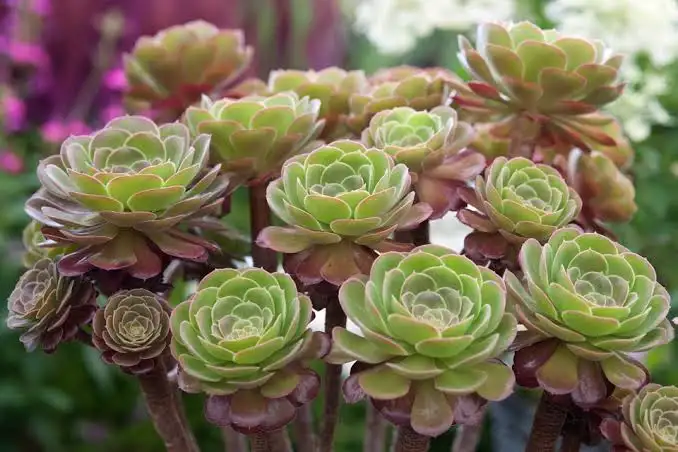
The Aeonium ‘Blushing Beauty’ is a hybrid of the Aeonium canariense and the Aeonium arboreum ‘Zwartkop’ succulents. Its rosette-shaped and spoon-shaped leaves are glossy green, tinged with red at the edges, and slightly hairy. With the prolonged exposure to the direct sun or during drought periods the color of the leaves intensifies and takes on a bordeux red color.
As this plant grows, it loses its basal leaves and discovers its smooth brown trunk. In spring you can admire its beautiful yellow flowers, which bloom from the center of the rosette. It is a perfect succulent plant to give a touch of liveliness to your balconies or window sills.
Aeonium Party Platter

Aeonium Party Platter is a slow growing Aeonium variety which can grow up to 40 cm in diameter. The plant forms a rosette of bright green small leaves. The short stem bears the geometrical rosette and the edge of the leaf is serrated. At the base of the stem is possible to find offsets, useful for propagation.
Leaves are arranged to form like a mosaic and the round rosette hide the stem and develops downwards until it touches the edge of the pot. For such a cheerful plant an equally joyful name was needed and for this it was called “Party Platter”. This plant like many others species of the genus Aeonium rarely blooms and the flower is sterile because this plant is a nursery cultivar.
Aeonium tabuliforme
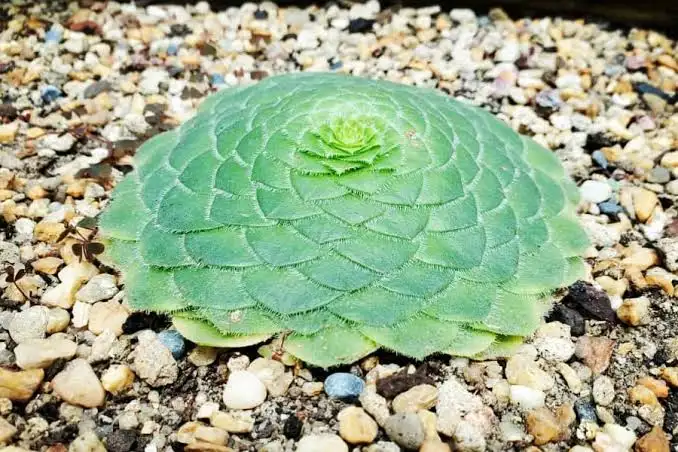
Aeonium tabuliforme, the flat-topped aeonium or saucer plant grows to form a compact rosette of overlapping, nearly flat leaves. The thick leaves are arranged in a rosette that grows up to 18 inches across. The yellow flowers grow on tall stems during the springtime. The plant looks really beautiful during the springtime with star-shaped flowers adorning the light green plant. The Aeonium tabuliforme is a short-lived Aeonium species that typically dies after flowering.
Aeonium Decorum
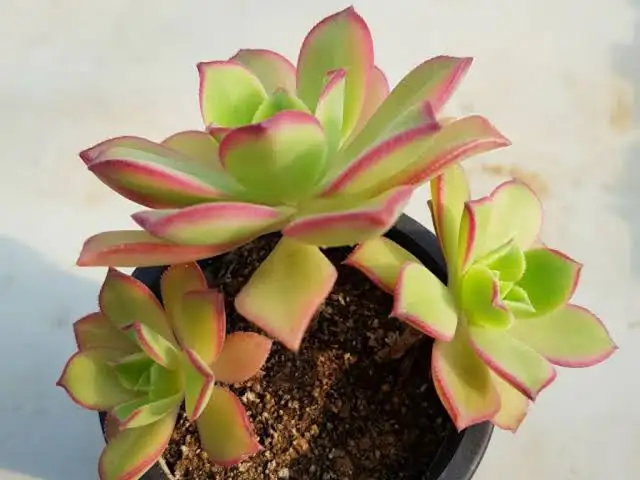
Aeonium Decorum is also known as the “Green Pinwheel.” It is a small succulent with dark green to yellowish-green leaves. It can grow up to 2 feet tall with rosettes that are up to 4 inches in diameter. Aeonium Decorum leaves are often reddish variegated along its margins. In late spring or summer, inflorescences rise above the foliage, and its flowers are star-shaped and pinkish. Even though Aeonium Decorum looks like a shrub, it doesn’t branch.
Aeonium canariense
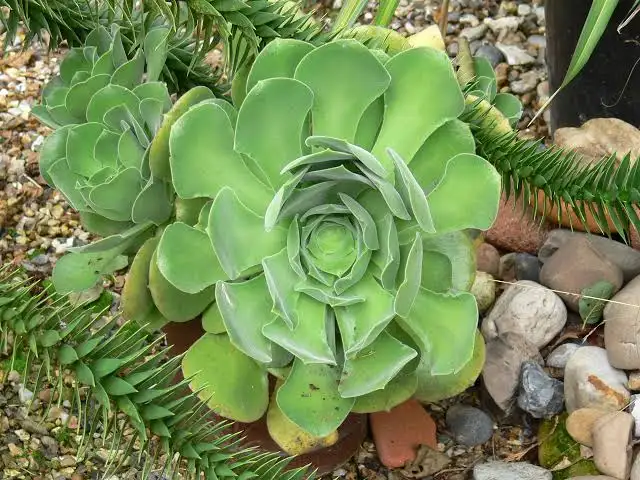
The aeonium canariense also known as the “giant velvet rose” is a very unique, beautiful succulent that grows fairly large. This succulent has bright green leaves with also some red tips when grown in full sun. It is like a rosette succulent, a lot of succulent growers mistake this succulent for the Irish rose succulent. The aeonium canariense succulent can grow all the way up to 12 inches tall and 8 inches wide. It can be used to create visual interest in containers, roof decks, lawn edges, borders, and even rock gardens.
Aeonium haworthii
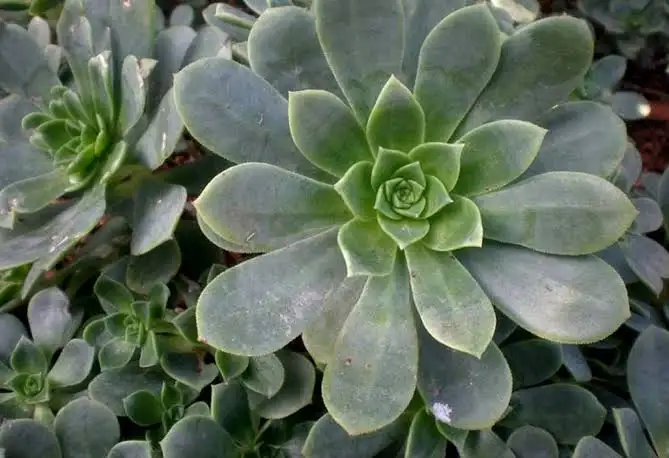
Aeonium haworthii, also known as Haworth’s aeonium or pinwheel has a freely branching growth habit and can range in height from between 6 to 12 inches tall with a spread of 18 to 24 inches. Leaves grow in rosettes 3 to 4 inches wide. The succulent leaves are blue-green and may have a slight red tinge along the margins. Blossoms are white, off-white or pale yellow and appear late in the springtime or early in the summer. White blooms may have a slightly pink tinge.
Aeonium dodrantale

Aeonium dodrantale, also known as Greenovia dodrantalis, has remarkably dense, tightly-packed, cupped, lime green leaves. Yellow flowers emerge from the rosette centers on stems up to 10″ tall. The rosettes will close tight during the dry season, often exhibiting a shape that is reminiscent of adorable tea cups. This mechanism helps them to avoid water loss. Plants offset freely and when given room to grow can form very large clusters. Often found growing naturally in rock crevices and rocky hill sides in shallow soils.
Noble aeonium

The noble aeonium is easily identifiable by its large rosettes of fleshy, yellow-green to red-brown leaves. The leaves of this succulent grow up to two inches in length and one inch in width, and the entire rosette can reach up to 15 inches in diameter. The plant takes several years to mature, at which point it produces a large inflorescence that blooms small, red, star-shaped flowers.
Aeonium arboreum
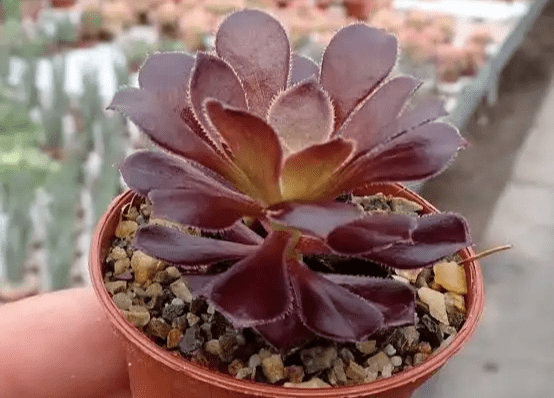
Aeonium arboreum, the tree aeonium, tree houseleek, or Irish rose produces long woody stems, on which numerous symmetrical rosettes grow. The leaves are fleshy, lanceolate, spatula-shaped, ending with a tip, generally of a green color (in some varieties even dark red or purple).
In spring-summer, it blooms with small flowers, ranging in color from white and yellow to greenish, which form clusters on the top of the rosettes. Aeonium arboreum is an outdoor plant, ideal for adorning your gardens or balconies, creating wonderful green carpets.
Aeonium arboreum ‘Zwartkop’
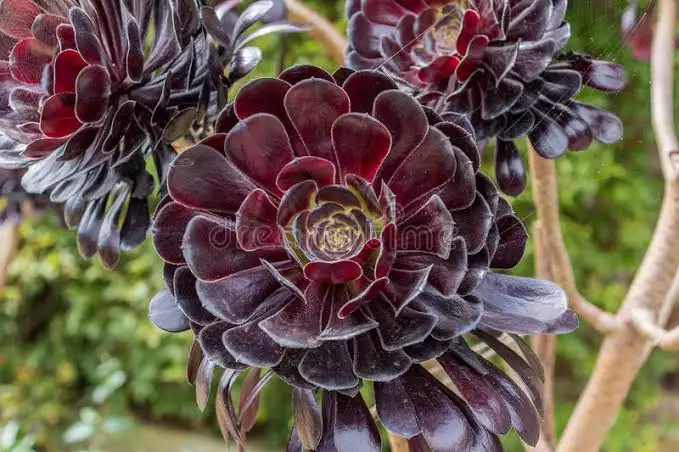
Aeonium arboreum ‘Zwartkop’ also referred to as Black rose is a striking succulent which forms clumps of 3-4 foot tall gray-brown stems that often branch near their base but not above. The long, bare stems hold large terminal rosettes of very dark purple (seemingly black) leaves.
Yellow star-shaped flowers that contrast well against the dark foliage form in long conical clusters from the center of the rosettes of mature older plants in summer, after which the stems bearing the flower die to the ground.
‘Zwartkop’ is the Dutch name it was registered under in the Abbey Gardens catalogs from the early 1980s. It also goes by the German name ‘Schwarzkopf‘, both of which can be translated into ‘Black Head’.
Aeonium appendiculatum
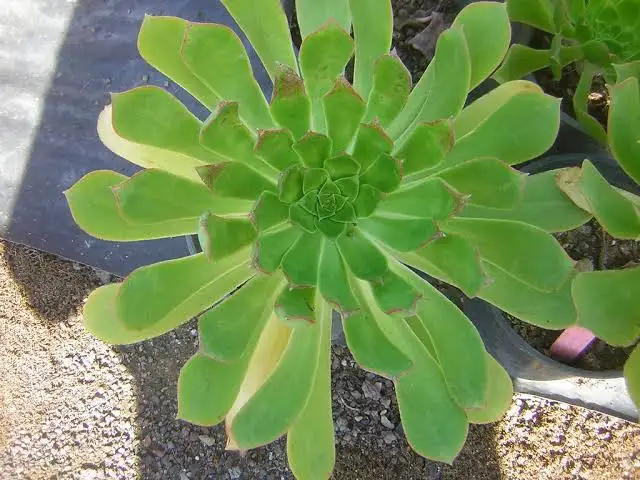
Aeonium appendiculatum is a perennial monocarpic unbranched succulent that grows up to 1m tall. Its rosettes are 30 – 35 cm in diameter and rather flat with leaves that are oblanceolate to subobovate, apically attenuate, strongly apiculate and usually mucronate, basally cuneate, glaucous and glabrous. Inflorescences are dome-shaped, with white and often pinkish variegated flowers.
Aeonium Mardi Gras

The Mardi Gras Aeonium is characterized by fantastic rosettes with emerald green and lemon yellow variegation. They also contain burgundy leaves, and they can also have some pink on them. The color intensifies from pink to burgundy if you have grown the plant in bright light but under a relaxed environment.
This slow-growing plant attains a maximum height of 10 cm and 15 cm wide. The rosettes can produce flowers, but it takes a long time for this to happen. These plants have flowers only once, and then they die. The succulent is named Mardi Gras after the colorful Mexican festival due to their colorfulness, as we have seen above.
Aeonium ‘Jack Catlin’
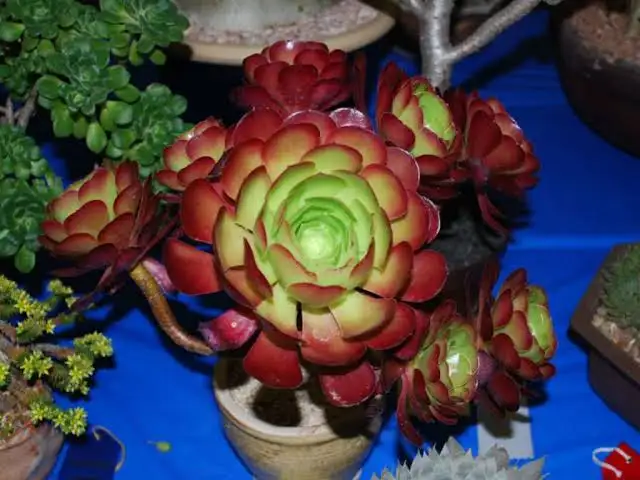
This beautiful Aeonium plant is a hybrid of A. tabuliforme and A. arboreum ‘Zwartkop’, created by Jack Catlin. It grows a rosette of red and slightly hairy leaves . With prolonged exposure to the sun, or during periods of drought, the color of the leaves intensifies and takes on a reddish-burgundy hue. As this plant grows, it loses its basal leaves and uncovers its smooth brown trunk. It is a perfect succulent to give an exotic touch to your balconies or window sills.
Aeonium ‘Velour’
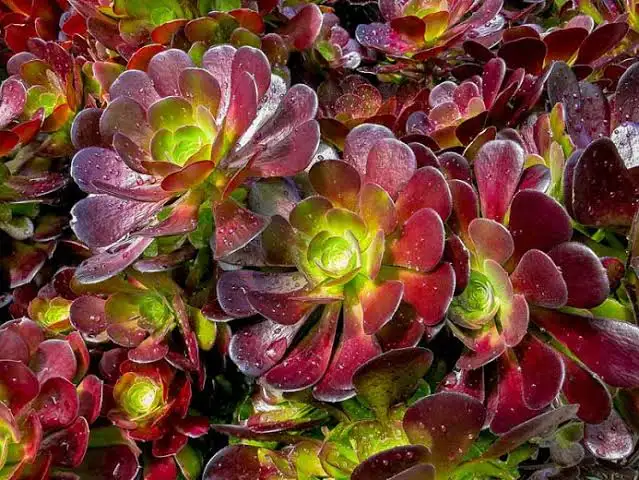
Aeonium ‘Velour’ is a hybrid between A. canariense and A. arboreum ‘Zwartkop’, created by Jack Catlin in 1976. Its main feature that differentiates it from A. ‘Blushing Beauty’ is its velvety leaves, from which it takes its name. Its spoon-shaped rosette-like leaves are shiny green in the center and tinged with an intense chocolate color at the edges.
With the prolonged exposure to the direct sun or during drought periods the color of the leaves intensifies and takes on a purple shade. As this plant grows, it loses its basal leaves and discovers its smooth brown trunk. In spring you can admire its beautiful yellow flowers, which bloom from the center of the rosette.
Aeonium ‘Sunburst’
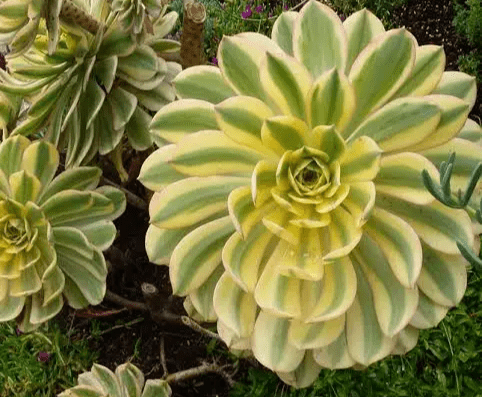
The sunburst is a variegated and branching succulent and as with the other varieties of Aeonium decorum, it’s very branched: on the top of each branch there is a rosette, about 15-20 centimeters wide. Its leaves are a fleshy colorful explosion composed of a bright green central stripe and a creamy yellow. Its margins, as in “Aeonium decorum tricolor”, are red: especially if exposed to direct light. Its inflorescence appears in summer and is a raceme with pale pink flowers.
Aeonium balsamiferum
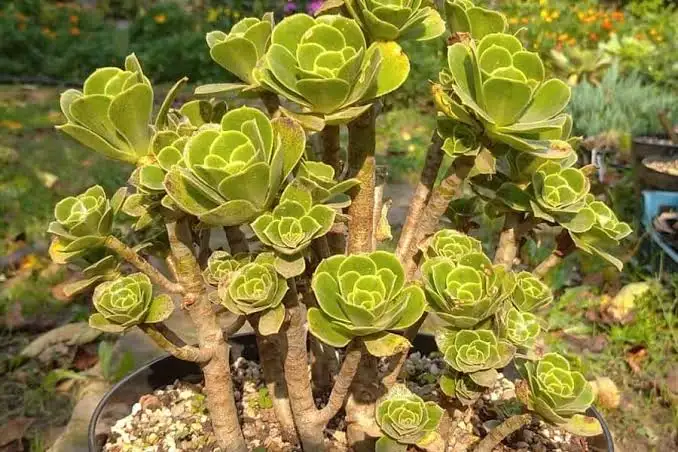
Aeonium balsamiferum is an upright growing shrub-like Aeonium plant, 3 to 4 feet tall with many near vertical branching succulent gray-brown colored stems grouped together with each tipped with tight 6 to 8 inch wide rosettes of slightly sticky light green spoon shaped leaves with soft pointed tips that have the distinct aroma of balsam. Small light yellow flowers in 6 to 10 inch long panicles occasionally rise above the foliage in mid-summer, but this doesn’t seem to be a common occurrence.
Aeonium sedifolium
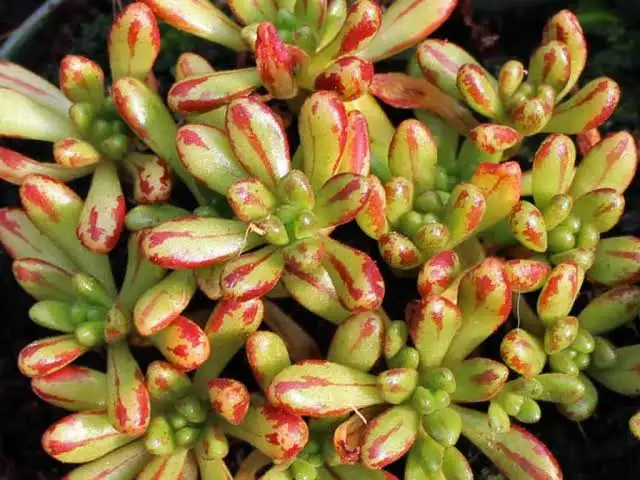
Aeonium sedifolium, also called “Dwarf Aeonium”. It a miniature plant, reaching maximum 15 centimeters of height, it is densely branched and it has really fleshy, tiny green leaves, with bright red veins. The name “Sedifolium” actually is a reference to this morphological resemblance.
Another feature that distinguish Aeonium sedifolium is the fact that the leaves in the clusters radiate upwards, while other Aeoniums have flat rosettes. Flowers are bright yellow, star-shaped. They grow in an inflorescence which is actually a stem, taller than the plant.
Aeonium Goochiae “Ballerina”
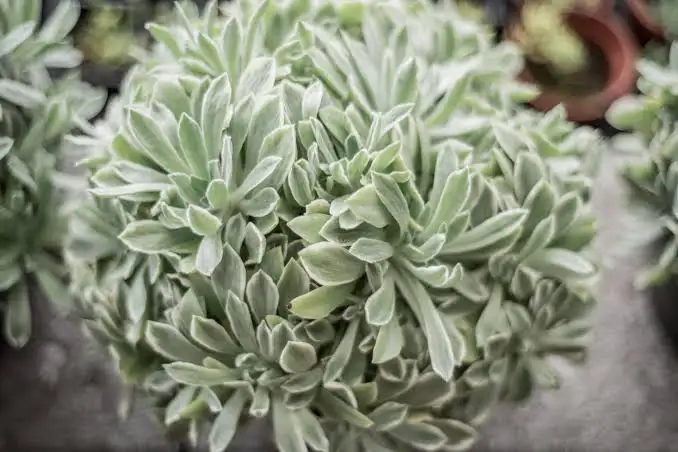
Aeonium Goochiae “Ballerina” is a perennial, evergreen, low growing Aeonium variety. It can reach the height of more or less 20 centimeters. Its leaves are slightly concave upward, hairy, pale green, with a white, crinkled margin. They are densely grouped in rosettes: each rosette grows on the top of a stem. Stems are numerous, intricate. Flowering comes in the middle of the spring. The inflorescence develops on short branches and the flowers are 1-2 centimeters big, are pinkish, with oblanceolate, pubescent in the inferior face, petals.
Aeonium hierrense
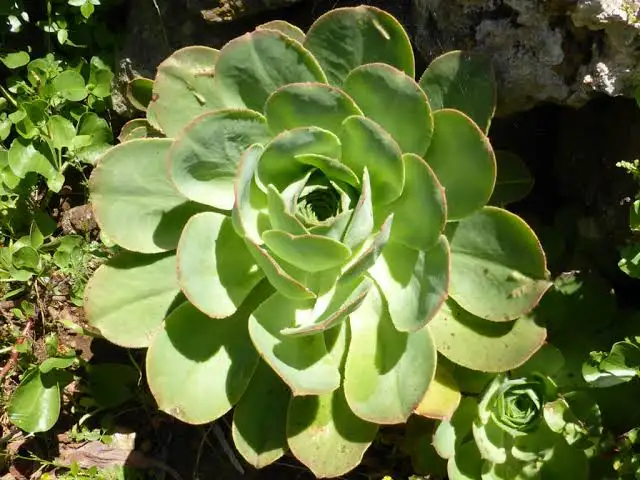
Aeonium hierrense is a beautiful large Aeonium with broad flat rosettes 18 to 24 inches wide of blue-green leaves that when drought stressed can flush pink or even red. These leaves crown a stout (to 2 inch thick) stem to 2 feet tall that is decoratively marked with old leaf scars. A monocarpic plant that, when mature, produces a large tower of white to pale pink flowers that rise above the leaves. Plant in full sun in a well-drained soil and water occasionally.
Aeonium Lancerottense
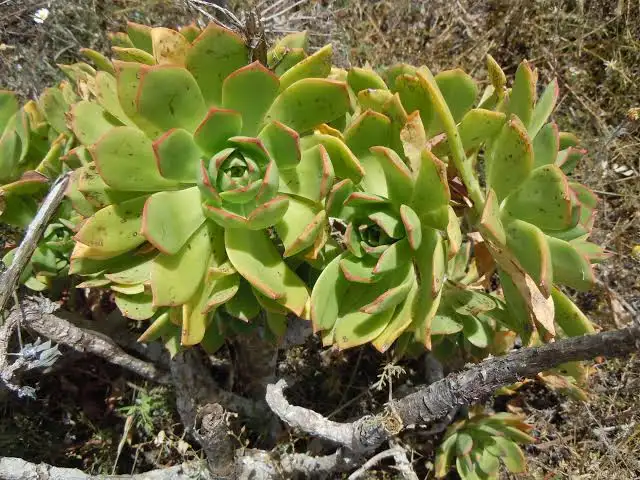
Aeonium Lancerottense is a relatively large growing rosette-forming succulent, with the natural plant habit being a round mound of stunning rosettes, accentuated by the bronze-tipped leaf margins which provide a trendy display, year round.
Aeonium Lancerottense does well in pots (including large terrariums), rockeries and wide range of gardens, and like all succulents is very drought tolerant making it a popular choice for low-maintenance landscape designs. The stylish rosettes make this variety a great addition to any garden.
Aeonium leucoblepharum
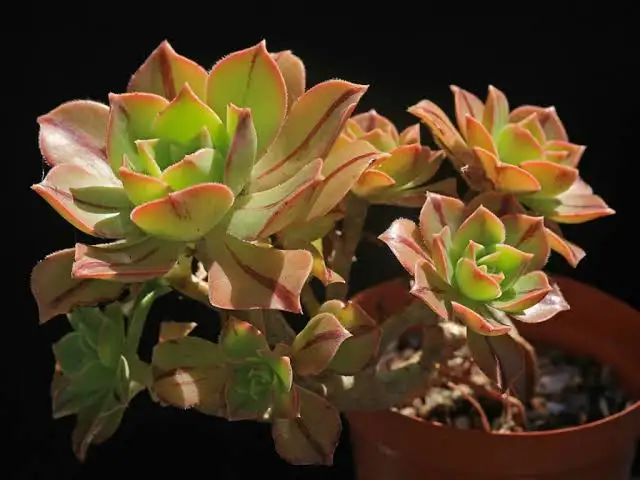
Aeonium leucoblepharum is an Aeonium variety which form a branched shrub up to 75-80 centimeters high and 50 cm wide. Each branch bear a rosette of pointed, green-reddish-pinkish leaves (the color depends on the exposure to sunlight: if the plant is put in a bright spot, the leaves become more pinkish).
In the central part of each leaf there is a really beautiful red stripe. This features make it really good for being put in terracotta pots. The inflorescence is a raceme of yellow flowers, with 7-10 petals. This species is really variable: this means that different individuals of the same species can present meaningful differences.
Aeonium lindleyi
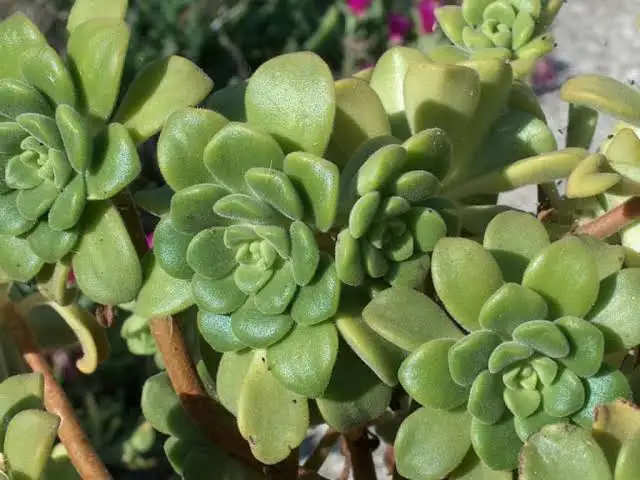
Aeonium lindleyi is a type of Aeonium plant with bushy growth formed by many small rosettes at the apex of thin stems. It has small and obovate leaves, ranging from green-yellowish to dark green. The entire epidermis is covered with a soft fluff that protects the plant and gives it an opaque, almost silvery in the sun. The blooming takes place in summer when, at the apex of long stems, small but graceful yellow star-shaped flowers bloom.
Aeonium urbicum

Aeonium urbicum is known as the salad bowl and saucer plant is a large plant that can reach six feet in height. Its most distinguishing feature as a decorative plant is its lush succulent leaves organized into beautiful rosettes. The edges of individual leaves are pink, further accentuating the appearance. The plant also produces white flowers every summer.
Aeonium undulatum

Aeonium undulatum, commonly known as Stalked Aeonium features large rosettes of fleshy, spoon-shaped, glossy green leaves (each leaf to 4-8 inch long). Leaves are often wavy-edged and sometimes have hair-fringed margins. Small, star-shaped, dark yellow flowers bloom in large terminal pyramidal panicles atop stems rising above the foliage rosettes to 1-2 inch tall. Most plants do not flower every year (some take up to 5 years to flower.
Aeonium simsii

Aeonium simsii is a small variety of Aeonium plant formed by a cluster of succulent rosettes of intense, deep green leaves, elongated and very numerous on the rosettes. A cute feature of the leaves of this plant are the ephemeral, nearly invisible soft white hairs on their edges. The maximum height of the rosettes of this plant is 12 centimeters, while the whole plant can reach a diameter of 30 centimeters and a height of 20 centimeters. The lower surface of the leaves, moreover, has some short dark green lines and the upper one has a brown line in the middle. This plant, like all Aeoniums is more appreciated for its leaves, rather than for its flowers.
Aeonium smithii

The name of the species was chosen in honor of the Norwegian botanist Smith. It is a peculiar shrub, that does not reach considerable sizes, consisting, especially at a young age, of thin stems, equipped with particular white and bristly hairs, similar to spiny hair, at the apex of which pleasant rosettes of wavy and spoon-shaped leaves grow; the leaves are of a beautiful lively green color, enriched by purple cuts sometimes even in relief, and by a characteristic down, that makes them truly unique. Between winter and spring its unique appearance is further enlivened by small yellow flowers, which contrast nicely with the brown of the peculiar “spots”.
Aeonium mascaense
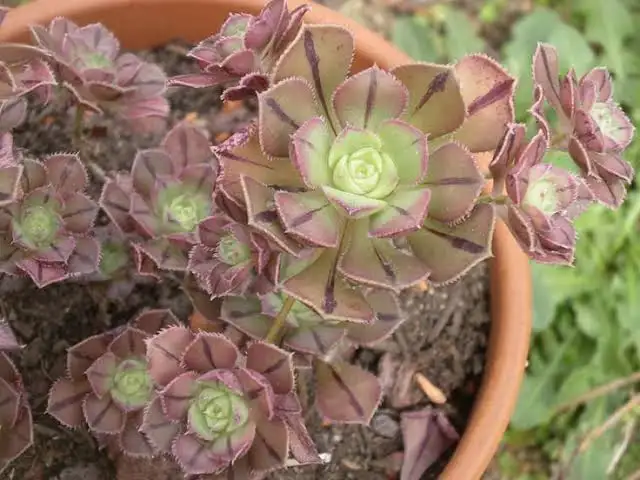
Aeonium mascaense is a hybrid between Aeonium haworthii and Aeonium sedifolium. It is characterized by a typical rather small rosette arrangement, which tends to develop at the apex of slender woody stems generally rather branched with the growth. The overall appearance that develops is that of a wonderful bouquet consisting of multiple colorful heads. Each rosette has ovoid leaves, ending in a small tip and, sometimes, meticulously ciliated along the margins.
The epidermis is one of the strengths of the succulent, which allows you to recognize it among many: in mature age, when the plant is subjected to abundant sunlight, the typical bright pale green colouration is tinged with a longitudinal line in the middle of each much darker leaf, of an almost black violaceous, often mottled as if painted with a brush.
Aeonium Cyclops

Aeonium Cyclops is a spectacular plant known for its dramatic color and magnificent size. Compared to other succulents, this plant has deeper anchoring roots that give it more stability despite growing bigger.
Aeonium Cyclops is a cross-breed between Aeonium arboreum “zwartkop” and Aeonium undulatum. It is also commonly known as “giant red Aeonium” because it forms rosettes of reddish-bronze tone. It is called Aeonium Cyclops because as the leaves grow, they overlap and then spread out, making its crimson color more visible and creating an illusion that it has a green “eye” at the center.
This succulent proliferates and produces small yellow, star-shaped flowers. Its flowering season is from late winter through early spring. Its unique and blooming color adds up to its unique and beautiful features.